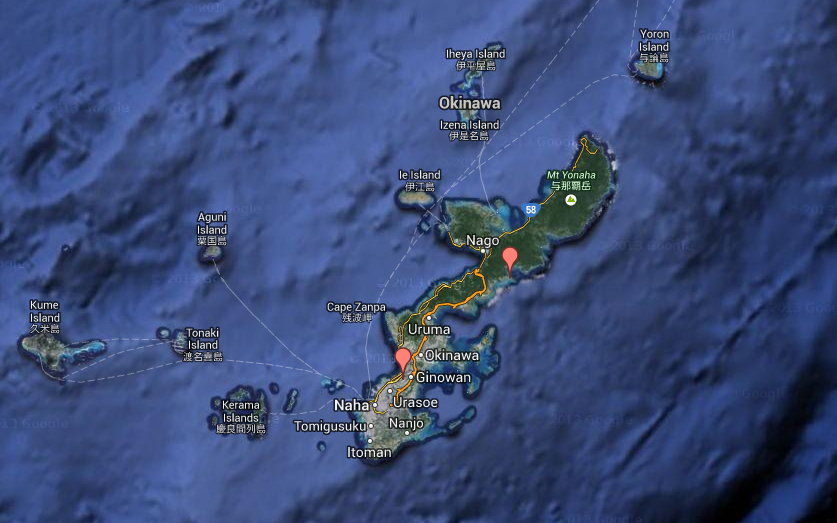
An MV-22 Osprey at MCAS Futenma U.S. Marine Corps photo by Lance Cpl. Jeraco Jenkins/Released
Finally Futenma: The Air Base Deal’s Place in The Pivot
What a belated air base deal says about the pivot to Asia. By Kevin Baron
Call it the most significant and celebrated piece of bureaucratic red tape in the Obama administration’s planned pivot to Asia -- and, by now, the most delinquent.
Pentagon officials announced with triumphant oomph on Friday that Japan’s governor of Okinawa has signed a landfill permit to allow construction to begin on a V-shaped runway off the island coast. The runway for years has been on the Pentagon’s must-have wish list in order to move a noisy air base, Marine Corps Air Station Futenma, from heavily populated central Okinawa to a coastal location. That shift, Pentagon officials have argued, would allow the U.S. to then move roughly 8,000 Marines and families off of Okinawa, lessening the controversial American footprint there, and send them to Guam. But first, the Marines need the coastal runway.
In reality, this week’s permit should be a poster child for just how difficult the U.S. vision for Pacific security has been to craft, much less achieve. It comes 17 years after the Pentagon’s so-called “Pacific Realignment” was originally conceived. By the end of 2013, the Defense Department planned to have completed not just the Futenma replacement move to the coast, but the massive shift of U.S. forces across bases in Japan, South Korea and Guam. But the plan relied on such an intricate series of bilateral deals and force shifts that it was doomed from the start. When it was unveiled, then- Pentagon spokesman Geoff Morrell said the realignment was so delicate that pulling one thread on it (like Futenma) would unravel the entire plan.
(Read more about the Pentagon's pivot to Asia here)
As it happened, years of protests on Okinawa, including from local politicians and environmentalists angry about a new runway into the ocean, kept the entire realignment in check. As the delays mounted, protests on Guam did too, over concerns about the impact of more than 10,000 Americans suddenly moving to their island. It all came to a screeching halt two years ago, when U.S. and Japanese defense and diplomatic officials gathered at the State Department to announce they were indefinitely delaying the Pacific realignment plan. In reality, the plan was dead.
Defense Secretary Chuck Hagel, in a statement on Friday, called this week’s deal “a critical part of the realignment of U.S. forces on Okinawa.” No mention of the broader Pacific realignment was made. Instead, Hagel argued the deal demonstrates the U.S. can resolve prickly problems in the region. With its closest ally, that is.
(Click on the map below to see where the Pentagon is moving in Okinawa)
“Reaching this milestone is a clear demonstration to the region that the alliance is capable of handling complex, difficult problems in order to deal effectively with 21st century security challenges,” Hagel said.
The reality is that with the Asia pivot, the Obama administration and U.S. military planners have long moved beyond Futenma replacement. All three of Obama’s defense secretaries -- Hagel, Leon Panetta and Robert Gates -- have made repeated trips across the Asia-Pacific region to encourage Asian leaders to have a greater sense of urgency in building their own alliances to handle more of their own security. Meanwhile, the Pentagon has focused on creating a new network that is built not on U.S. bases housing thousands of troops, but on permission slips to use ports, air strips and other strategically important facilities, when and if the U.S. needs them.
In the past two years, the public has heard less from the Pentagon about Futenma and Guam and more about gaining access to Vietnam’s Cam Ranh Bay, creating a humanitarian air base hub in Thailand, and other similar agreements that could permit U.S. troops to land in locations from Malaysia to Australia.
The Okinawa deal is significant, to be sure. Washington wanted it. Tokyo wanted it. In the end, Okinawa’s political leadership wanted it, too. But a better demonstration of Washington’s ability to shape Pacific security is already underway. Hagel, in less than one year as Defense secretary, has made four trips to the Asia-Pacific, receiving warm welcomes for the U.S. pivot in key Southeast Asian capitals eager for U.S. trade and engagement, and clearly spooked by the threat of Islamic-based terrorism spreading from the Middle East to their doorstep. With Futenma mercifully in the rearview mirror for the Pentagon’s Asia desk, Hagel in 2014 is expected to perhaps his most significant Asia trip of all, when he travels to Beijing.





